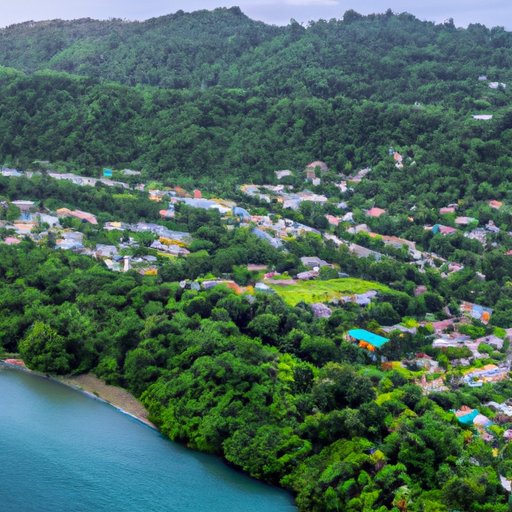Introduction
When it comes to locating Trinidad and Tobago on a map, there is often confusion as to which continent it belongs to. Some say North America, some South America, and some even the Caribbean. This uncertainty can be misleading since geography is a fundamental aspect of a country’s identity. In this article, we will explore the location of Trinidad and Tobago, its unique geography, and the impact it has on its culture.
Locating Trinidad and Tobago: A Guide to Its Continent
Trinidad and Tobago is located in the Caribbean Sea, just off the coast of Venezuela. To the north, across the Caribbean Sea, lies the Dominican Republic, Cuba, and the other Caribbean islands. To the south of Trinidad and Tobago is the South American continent, which includes Venezuela, Brazil, and Argentina, among other countries.
The country consists of two main islands, Trinidad and Tobago. Trinidad is the larger of the two islands, and Tobago is about 20 miles northeast of Trinidad.
One of the main reasons for the confusion regarding the continent of Trinidad and Tobago is its geographic location. The country is situated on the continental shelf of South America, which means it shares some of the same characteristics and features as the South American continent.
To better understand Trinidad and Tobago’s location, you can refer to a map or use an online map application. You’ll find the country on the northeastern side of the South American continent, marked by its two islands of Trinidad and Tobago.
Is Trinidad and Tobago in North or South America?
The location of Trinidad and Tobago has been a topic of debate among geographers and cartographers for many years. Some classify it as part of North America, while others say it belongs to South America. There are several arguments for both sides.
One of the reasons that Trinidad and Tobago is often classified as being a part of North America is because of its historical connection to Caribbean island nations. The Caribbean is often considered to be part of North America, and since Trinidad and Tobago belongs to the Caribbean, it is sometimes classified as such.
On the other hand, the fact that Trinidad and Tobago is located on the continental shelf of South America is one of the main reasons why some classify it as part of South America. The continental shelf is a geological feature that extends out from the continent into the sea and contains similar geographic characteristics.
In conclusion, whether Trinidad and Tobago is part of North or South America is subjective and depends on the geographical context in which it is being discussed.
Exploring Trinidad and Tobago’s Culture and Geography
Trinidad and Tobago’s geographical location plays a significant role in its culture. Located on the southeastern edge of the Caribbean, their location puts them in close proximity to South America, and their unique geography has shaped their identity.
From a cultural perspective, Trinidad and Tobago is heavily influenced by the French, Spanish, British, and West African cultures. The country has a diverse population, and this is reflected in its customs, language, religion, and food. Festival celebrations like Carnival and Divali promote music, dance, and local folklore, and these celebrations continue to be an important part of Trinidadian culture.
The geography of Trinidad and Tobago is also unique. The country is located just south of the hurricane belt, which means that it is rarely affected by hurricanes. The islands are also home to several protected wetlands, coral reefs, and rare wildlife. Trinidad and Tobago is also home to the world’s largest natural pitch lake, and it is a significant source of asphalt used in road constructions worldwide.
Trinidad and Tobago: An Island Nation in the Caribbean
As an island nation, Trinidad and Tobago’s geography has a significant impact on its culture and economy. The country relies heavily on tourism, and its beautiful beaches, vibrant festivals and unique geography attract visitors from around the globe. Most visitors to the country arrive via the Piarco International Airport located on the island of Trinidad.
The island nation also faces some unique challenges. Most of the population and infrastructure are located on Trinidad, leaving Tobago underdeveloped. This imbalance has led to political tension and, in some cases, attempts at secession. However, the island’s stunning beauty, warm weather, and diverse culture continue to attract visitors from all over the world.
The Diversity of South America: Trinidad and Tobago’s Place in the Continent
Trinidad and Tobago’s location on the South American continent makes it an excellent example of the diversity found throughout the continent. The countries of South America are diverse in many ways—landscape, culture, language, religion, and more.
At the northernmost point of South America, Venezuela is a country that shares many cultural similarities with Trinidad and Tobago, such as their love for music, vibrant lifestyle and general warmth for people. Further south in the Andes, you will find countries like Peru, home to the ancient Inca culture, with several archaeological sites to tour. East of the Andes, you will find Argentina, the birthplace of Tango and well-known for its wines.
South America is home to several of the world’s most exciting destinations, and a trip to the continent can be an incredible opportunity to experience the diversity of the region.
Conclusion
Trying to classify Trinidad and Tobago into a single continent is challenging, if not impossible. Nonetheless, this small island nation on the South American continent has a rich heritage, unique geography, and lively culture, making it an excellent example of how complex and fascinating our world can be. No matter where you see Trinidad and Tobago on a map, this little slice of paradise continues to attract visitors from all over the world.
